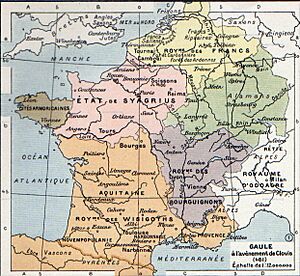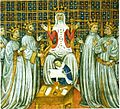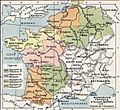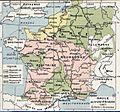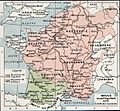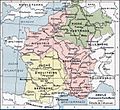Francia facts for kids
Francia was a very important kingdom in Europe a long, long time ago. It was also known as the Kingdom of the Franks or the Frankish Empire. This powerful kingdom started in 481 AD.
The Franks were a group of Germanic people. Their kingdom grew out of parts of the old Western Roman Empire. Francia was first a province of the Western Roman Empire. Later, it became a strong independent state. After a big agreement called the Treaty of Verdun in 843, Francia split into different parts. One part, West Francia, became the country we know today as France. Another part, East Francia, became the country of Germany.
Contents
What Was the Frankish Kingdom?
The Frankish Kingdom was one of the most important states in Europe after the fall of the Western Roman Empire. It helped shape the future of many European countries. The Franks were a group of Germanic tribes. They settled in what is now modern-day France and Germany. Their kingdom grew to be very large and powerful.
How Francia Began
The Frankish Kingdom was founded by a famous leader named Clovis I. He became king in 481 AD. Clovis was very skilled at fighting and leading. He managed to unite many different Frankish tribes under his rule. This made the Franks much stronger.
Clovis also expanded his kingdom by conquering lands that used to belong to the Roman Empire. He defeated other Germanic groups and Roman armies. This helped create a large and stable kingdom. Clovis also became a Christian. This was a very important step for the Franks. It helped them get along better with the people they ruled. It also gave them support from the Christian Church.
Important Frankish Leaders
After Clovis I, other strong leaders helped Francia grow even more. One of the most famous was Charlemagne. He ruled much later, from 768 to 814 AD. Charlemagne was a brilliant military leader. He expanded the Frankish Empire to its largest size. His empire covered much of Western and Central Europe.
Charlemagne was crowned Emperor by the Pope in 800 AD. This showed how powerful and important the Frankish Empire had become. He also encouraged learning and education. He brought scholars to his court. This period is sometimes called the "Carolingian Renaissance." It was a time when art, writing, and learning became very important again.
How Francia Divided
The Frankish Empire became very large under leaders like Charlemagne. But after Charlemagne died, his grandsons began to fight over who should rule. In 843 AD, they signed the Treaty of Verdun. This treaty officially divided the Frankish Empire into three main parts.
- West Francia was given to Charles the Bald. This part eventually became the country of France.
- East Francia was given to Louis the German. This part later developed into the country of Germany.
- Middle Francia was given to Lothair I. This middle kingdom was a long, narrow strip of land. It included parts of Italy, Burgundy, and the Netherlands. This kingdom did not last very long. Its lands were later divided between West and East Francia.
This division was a very important moment in European history. It set the stage for the development of modern France and Germany. The Frankish Kingdom, though it split, left a lasting impact on the culture, laws, and politics of Europe.
Images for kids
-
The division of Francia on Clovis's death (511). The kingdoms were not geographic unities because they were formed in an attempt to create equal-sized fiscs. The discrepancy in size reveals the concentration of Roman fiscal lands.
-
The division of Gaul on Chlothar I's death (561). Though more geographically unified realms were created out of the second fourfold division of Francia, the complex division of Provence created many problems for the rulers of Burgundy and Austrasia.
-
The Frankish Kingdom of Aquitaine (628). The capital of Aquitaine was Toulouse. It included Gascony and was the basis of the later Duchy of Aquitaine.
-
Francia and neighbouring Slavic peoples c. 650
-
Gaul at the death of Pepin of Heristal (714). At this time the vast duchy of Aquitaine (yellow) was not a part of the Frankish kingdom.
-
The growth of Frankish power, 481–814, showing Francia as it originally was after the crumbling of the Western Roman Empire. It was located northeasterly of that during the time of Constantine the Great.
-
Frankish expansion from the early kingdom of Clovis I (481) to the divisions of Charlemagne's Empire (843/870).
-
The Carolingian Empire at its greatest extent, with borders displaying the three territorial divisions of 843, from left to right:
- West Francia or the West Frankish Kingdom: Charles the Bald, King of the West Franks.
- Middle Francia or the Middle Frankish Kingdom: Lothair I, King of the Middle Franks, nominally titled Emperor. This kingdom lasted only until 869.
- East Francia or the East Frankish Kingdom: Louis the German, King of the East Franks.
See also
 In Spanish: Reino de los francos en la época merovingia para niños
In Spanish: Reino de los francos en la época merovingia para niños


